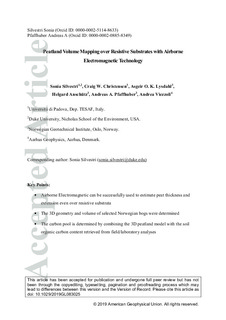| dc.contributor.author | Silvestri, Sonia | |
| dc.contributor.author | Christensen, Craig | |
| dc.contributor.author | Lysdahl, Asgeir Olaf Kydland | |
| dc.contributor.author | Anschütz, Helgard | |
| dc.contributor.author | Pfaffhuber, Andreas Aspmo | |
| dc.contributor.author | Viezzoli, Andrea | |
| dc.date.accessioned | 2019-06-24T06:26:31Z | |
| dc.date.available | 2019-06-24T06:26:31Z | |
| dc.date.created | 2019-06-11T08:53:26Z | |
| dc.date.issued | 2019 | |
| dc.identifier.issn | 0094-8276 | |
| dc.identifier.uri | http://hdl.handle.net/11250/2601749 | |
| dc.description.abstract | Despite the importance of peatlands as carbon reservoirs, a reliable methodology for the detection of peat volumes at regional scale is still missing. In this study we explore for the first time the use of Airborne Electromagnetic (AEM) to detect and quantify peat thickness and extension of two bogs located in Norway, where peat lays over resistive bedrock. Our results show that when calibrated using a small amount of field measurements, AEM can successfully detect peat volume even in less ideal conditions, i.e. relatively resistive peat over resistive substrata. We expect the performance of AEM to increase significantly in presence of a conductive substratum without need of calibration with field data. The organic carbon content retrieved from field surveys and laboratory analyses combined with the 3D model of the peat extracted from AEM allowed us to quantify the total organic carbon of the selected bogs, hence assessing the carbon pool. | |
| dc.language.iso | eng | |
| dc.title | Peatland Volume Mapping over Resistive Substrates with Airborne Electromagnetic Technology | |
| dc.type | Peer reviewed | |
| dc.type | Journal article | |
| dc.description.version | acceptedVersion | |
| dc.source.journal | Geophysical Research Letters | |
| dc.identifier.doi | 10.1029/2019GL083025 | |
| dc.identifier.cristin | 1703817 | |
| dc.relation.project | EC/H2020/747809 | |
| cristin.unitcode | 7452,3,2,0 | |
| cristin.unitname | Geokartlegging | |
| cristin.ispublished | true | |
| cristin.fulltext | postprint | |
| cristin.qualitycode | 2 | |
